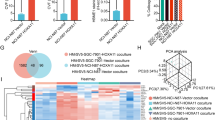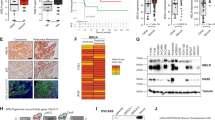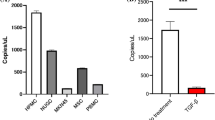Abstract
Scirrhous gastric cancer is frequently associated with peritoneal dissemination, and the interaction of cancer cells with peritoneal mesothelial cells (PMCs) is crucial for the establishment of the metastasis in the peritoneum. Although cells derived from PMCs are detected within tumors of peritoneal carcinomatosis, how PMCs are incorporated into tumor architecture is not understood. The present study shows that PMCs create the invasion front of peritoneal carcinomatosis, which depends on activation of Tks5 in PMCs. In peritoneal tumor implants, PMCs represent majority of cells located at the invasive edge of the cancer tissue. Exogenously implanted PMCs and host PMCs aggressively invade into abdominal wall upon the peritoneal inoculation of cancer cells, and PMCs locate ahead of cancer cells in the direction of invasion. Tks5, a substrate of Src kinase, is predominantly expressed in the PMCs of cancer tissue, and promotes the invasion of PMCs and cancer cells. Expression and activation of Tks5 was induced in PMCs following their exposure to gastric cancer cells, and increased Tks5 expression was detected in PMCs located at the invasion front. Reduced Tks5 expression in PMCs blocked PMC invasion, which in turn prevents cancer cell invasion both in vitro and in vivo. The peritoneal dissemination of gastric cancer was significantly increased by mixing cancer cells and PMCs, and was suppressed by knockdown of Tks5 in PMCs. These results suggest that cancer-activated PMCs create invasion front by guiding cancer cells. Signaling leading to Tks5 activation in PMCs may be a suitable therapeutic target for prevention of peritoneal carcinomatosis.
This is a preview of subscription content, access via your institution
Access options
Subscribe to this journal
Receive 50 print issues and online access
$259.00 per year
only $5.18 per issue
Buy this article
- Purchase on Springer Link
- Instant access to full article PDF
Prices may be subject to local taxes which are calculated during checkout







Similar content being viewed by others
References
Otsuji E, Kuriu Y, Okamoto K, Ochiai T, Ichikawa D, Hagiwara A et al. Outcome of surgical treatment for patients with scirrhous carcinoma of the stomach. Am J Surg 2004; 188: 327–332.
Takemura S, Yashiro M, Sunami T, Tendo M, Hirakawa K Novel models for human scirrhous gastric carcinoma in vivo. Cancer Sci 2004; 95: 893–900.
Nashimoto A, Akazawa K, Isobe Y, Miyashiro I, Katai H, Kodera Y et al. Gastric cancer treated in 2002 in Japan: 2009 annual report of the JGCA nationwide registry. Gastric Cancer 2013; 16: 1–27.
Schauer M, Peiper M, Theisen J, Knoefel W Prognostic factors in patients with diffuse type gastric cancer (linitis plastica) after operative treatment. Eur J Med Res 2011; 16: 29–33.
Yonemura Y, Endou Y, Sasaki T, Hirano M, Mizumoto A, Matsuda T et al. Surgical treatmentfor peritoneal carcinomatosis from gastric cancer. Eur J Surg Oncol 2010; 36: 1131–1138.
Yashiro M, Hirakawa K Cancer-stromal interactions in scirrhous gastric carcinoma. Cancer Microenviron 2010; 3: 127–135.
Tsukada T, Fushida S, Harada S, Yagi Y, Kinoshita J, Oyama K et al. The role of human peritoneal mesothelial cells in the fibrosis and progression of gastric cancer. Int J Oncol 2012; 41: 476–482.
Mutsaers SE The mesothelial cell. Int J Biochem Cell Biol 2004; 36: 9–16.
Yung S, Chan TM Intrinsic cells: mesothelial cells—central players in regulating inflammation and resolution. Perit Dial Int 2009; 29: S21–S27.
Jayne DG, Perry SL, Morrison E, Farmery SM, Guillou PJ Activated mesothelial cells produce heparin-binding growth factors: implications for tumour metastasis. Br J Cancer 2000; 82: 1233–1238.
Sako A, Kitayama J, Yamaguchi H, Kaisaki S, Suzuki H, Fukatsu K et al. Vascular endothelial growth factor synthesis by human omental mesothelial cells is augmented by fibroblast growth factor-2: possible role of mesothelial cell on the development of peritoneal metastasis. J Surg Res 2003; 115: 113–120.
Yanez-Mo M, Lara-Pezzi E, Selgas R, Ramírez-Huesca M, Domínguez-Jeménez C, Jiménez-Heffernan JA et al. Peritoneal dialysis and epithelial-to-mesenchymal transition of mesothelial cells. N Eng J Med 2003; 348: 403–413.
Aroeira LS, Aguilera A, Selgas R, Ramirez-Huesca M, Perez-Lozano ML, Cirugeda A et al. Mesenchymal conversion of mesothelial cells as a mechanism responsible for high solute transport rate in peritoneal dialysis: role of vascular endothelial growth factor. Am J Kidney Dis 2005; 46: 938–948.
Aroeira LS, Aguilera A, Sánchez-Tomero JA, Bajo MA, del Peso G, Jimenez-Heffernan JA et al. Epithelial to mesenchymal transition and peritoneal membrane failure in peritoneal dialysis patients: pathologic significance and potential therapeutic interventions. J Am Soc Nephrol 2007; 18: 2004–2013.
Kajiyama H, Shibata K, Ino K, Nawa A, Mizutani S, Kikkawa F Possible involvement of SDF-1alpha/CXCR4-DPP IV axis in TGF-beta1-induced enhancement of migratory potential in human peritoneal mesothelial cells. Cell Tissue Res 2007; 330: 221–229.
Sandoval P, Jiménez-Heffernan JA, Rynne-Vidal Á, Pérez-Lozano ML, Gilsanz Á, Ruiz-Carpio V et al. Carcinoma-associated fibroblasts derive from mesothelial cells via mesothelial-to-mesenchymal transition in peritoneal metastasis. J Pathol 2013; 231: 517–531.
Lv ZD, Wang HB, Dong Q, Kong B, Li JG, Yang ZC et al. Mesothelial cels differentiate into fibroblast-like cells under the scirrhous gastric cancer microenvironment and promote peritoneal carcinomatosis in vitro and in vivo. Mol Cell Biochem 2013; 377: 177–185.
Abram CL, Seals DF, Pass I, Salinsky D, Maurer L, Roth TM et al. The adaptor protein Fish associates with members of the ADAMs family and localizes to podosomes of Src-transformed cells. J BiolChem 2003; 278: 16844–16851.
Blouw B, Seals DF, Pass I, Diaz B, Courtneidge SA A role for podosome/invadopodia scaffold protein Tks5 in tumor growth in vivo. Eur J Cell Biol 2008; 87: 555–567.
Burger KL, Davis AL, Isom S, Mishra N, Seals DF The podosome marker protein Tks5 regulates macrophage invasive behavior. Cytoskeleton 2011; 68: 694–711.
Courtneidge SA Cell migration and invasion in human disease: the Tks adaptor proteins. Biochem Soc Trans 2012; 40: 129–132.
Weaver AM Invadopodia: specialized cell structures for cancer invasion. Clin Exp Metastasis 2006; 23: 97–105.
Yamaguchi H, Condeelis J Regulation of the actin cytoskeleton in cancer cell migration and invasion. Biochim Biophys Acta 2007; 1773: 642–652.
Linder S The matrix corroded: podosomes and invadopodia in extracellular matrix degradation. Trends Cell Biol 2007; 17: 107–117.
Gimona M, Buccione R, Courtneidge SA, Linder S Assembly and biological role of podosomes and invadopodia. Curr Opin Cell Biol 2008; 20: 235–241.
Murphy DA, Courtneidge SA The ‘ins’ and ‘outs’ of podosomes and invadopodia: characteristics, formation and function. Nat Rev Mol Cell Biol 2012; 12: 413–426.
Li CMC, Chen G, Dayton TL, Kim-Kiselak C, Hoersch S, Whittaker CA et al. Differential Tks5 isoform expression contributes to metastatic invasion of lung adenocarcinoma. Genes Dev 2013; 27: 1557–1567.
Oikawa T, Itoh T, Takenawa T Sequential signals toward podosomeformation in NIH-src cells. J Cell Biol 2008; 182: 157–169.
Stylli SS, Stacey TT, Verhagen AM, Xu SS, Pass I, Courtneidge SA et al. Nck adaptor proteins link Tks5 to invadopodia actin regulation and ECM degradation. J Cell Sci 2009; 122: 2727–2740.
Fekete A, Bogel G, Pesti S, Péterfi Z, Geiszt M, Buday L . EGF regulates tyrosine phosphorylation and membrane-translocation of the scaffold protein Tks5. J Mol Sinal 2013; 8: 8.
Murphy DA, Diaz B, Bromann PA, Tsai JH, Kawakami Y, Maurer J et al. A Src-Tks5 pathway is required for neural crest cell migration during embryonic development. PLos ONE 2011; 6: e22499.
Yanagihara K, Takigahira M, Tanaka H, Komatsu T, Fukumoto H, Koizumi F Development and biological analysis of peritoneal metastasis mouse models for human scirrhous stomach cancer. Cancer Sci 2005; 96: 323–332.
Fuyuhiro Y, Yashiro M, Noda S, Kashiwagi S, Matsuoka J, Doi Y et al. Upregulation of cancer-associated myofibroblasts by TGF-β from scirrhous gastric carcinoma cells. Br J Cancer 2011; 105: 996–1001.
Satoyoshi R, Kuriyama S, Aiba N, Yashiro M, Tanaka M . Asporin activates coordinated invasion of scirrhous gastric cancer and cancer associated fibroblasts. Oncogene 2014 e-pub ahead of print 20 January (doi:10.1038/onc.2013.584).
Shama VP, Eddy R, Entenberg D, Kai M, Gertler FB, Condeelis J . Tks5 and SHIP2 regulate invadopodium maturation, but not initiation, in breast carcinoma cells. Curr Biol 2014; 23: 2079–2089.
Seals DF, Azucena EF Jr, Pass I, Tesfay L, Gordon R, Woodrow M et al. The adaptor protein Tks5/Fish is required for podosome formation and function, and for the protease-driven invasion of cancer cells. Cancer Cell 2005; 7: 155–165.
Burger KL, Learman BS, Boucherle AK, Sirintrapun SJ, Isom S, Diaz B et al. Src-dependent Tks5 phosphorylation regulates invadopodia-associated invasion in prostate cancer cells. Prostate 2013; 74: 134–148.
Nishimura S, Hirakawa K, Yashiro M, Inoue T, Matsuoka T, Fujihara T et al. TGF-β1 produced by gastric cancer cells affects mesothelial cell morphology in peritoneal dissemination. Int J Oncol 1998; 12: 847–851.
Yanagihara K, Tanaka H, Takigahira M, Ino Y, Yamaguchi Y, Toge T et al. Establishment of two cell lines from human gastric scirrhous carcinoma that possess the potential to metastasize spontaneously in nude mice. Cancer Sci 2004; 95: 575–582.
Motoyama T, Hojo H, Watanabe H Comparison of seven cell lines derived from human gastric carcinomas. Acta Pathol Jpn 1986; 36: 65–83.
Shimamura S, Sasaki K, Tanaka M The Src substrate SKAP2 regulates actin assembly by interacting with WAVE2 and cortactin proteins. J Biol Chem 2013; 288: 1171–1183.
Acknowledgements
We thank Murata K (Department of Environmental Health Sciences, Akita University School of Medicine) for advice and discussion about statistics. This work was supported by JSPS KAKENHI (Grant Nos 25290042 and 26640068 to MT) Takeda Science Foundation (MT) and the National Cancer Center Research and Development Fund (Grant No. 23-A-9 to MT).
Author information
Authors and Affiliations
Corresponding author
Ethics declarations
Competing interests
The authors declare no conflict of interest.
Additional information
Supplementary Information accompanies this paper on the Oncogene website
Supplementary information
Rights and permissions
About this article
Cite this article
Satoyoshi, R., Aiba, N., Yanagihara, K. et al. Tks5 activation in mesothelial cells creates invasion front of peritoneal carcinomatosis. Oncogene 34, 3176–3187 (2015). https://doi.org/10.1038/onc.2014.246
Received:
Revised:
Accepted:
Published:
Issue Date:
DOI: https://doi.org/10.1038/onc.2014.246
This article is cited by
-
Transgelin promotes lung cancer progression via activation of cancer-associated fibroblasts with enhanced IL-6 release
Oncogenesis (2023)
-
Decreased exosome-delivered miR-486-5p is responsible for the peritoneal metastasis of gastric cancer cells by promoting EMT progress
World Journal of Surgical Oncology (2021)
-
Association of lncRNA SH3PXD2A-AS1 with preeclampsia and its function in invasion and migration of placental trophoblast cells
Cell Death & Disease (2020)
-
Macrophage-mediated transfer of cancer-derived components to stromal cells contributes to establishment of a pro-tumor microenvironment
Oncogene (2019)
-
Mesothelial to mesenchyme transition as a major developmental and pathological player in trunk organs and their cavities
Communications Biology (2018)



